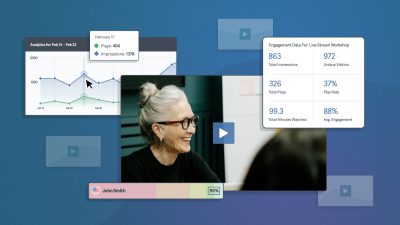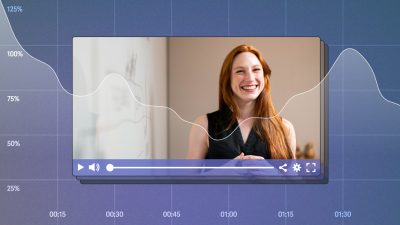No video exists in a vacuum. It’s really important to consider the context of any video you create.
For a simple starting point, what does the site look like where you are embedding it? What broader business aims are you trying to achieve by putting video on that page? How does this fit with the rest of your marketing strategy and your customer acquisition cycle?
Keep reading to uncover how much the context of your video matters, and what you can do to optimize it.
Internal Context
Here, we are referring to everything that is happening behind the scenes, before you ever share your video. This includes all the goings on within your company when the video is being conceptualized. To help you think through how this applies to your video project, consider the following points:
- Who are the internal stakeholders for this video project?
- How would you describe your brand voice?
- What perspective are you exploring in this video?
- What is the ultimate goal for this video?
This is all about setting the scene and developing the character of your company. Not only will this give your video more personality, it will ensure it fits in with the rest of your content strategy.
Strategic Context
Very few videos are truly one-off endeavors. Most exist within a content ecosystem that is made up of many parts.
If you could map out your customer acquisition funnel, for example, where would this video fit in? Is it driving awareness, engagement, or retention?
Consider the other efforts you are making towards the same aim along with your video. If you are promoting white papers, slide decks, or other forms of high value content, make sure each piece is aligned, on message, and features consistent branding.
It also might make sense to offer different content types to different customer segments. Joining an email list is a smaller commitment in many ways than downloading information about a product, or spending 5-10 minutes watching an explainer video.
Location, Location, Location
This is a far simpler exercise in why the surroundings of your videos matter. Here, we are looking at visible elements on the page where the video will be published.
A recent scandal in video ads highlights why location on the page is so key. According to the Wall Street Journal, a website came under scrutiny for several tiny sites embedded throughout its pages. Each embedded site was the size of a single pixel and not visible to the human eye. These embedded sites served up video ads to site visitors, which advertisers had paid for. Had they known the placement, they probably wouldn’t have.
Maybe those ads could have been relevant to the visitor on the page. Given their placement on the page, they have practically zero impact on the visitor experience. For the advertiser placing those ads, however, their ROI and overall experience with that ad network would be very negative.
To optimize the on-page context of the video, think about the goal you want to achieve by including video on the page. Try to think through these questions:
- What other elements are on the page, and how are they arranged?
- Is it clear there even is a video on the page, or is it hidden below the fold?
- Would a video overlay work on the page?
- Does the video have an attractive poster frame that makes you want to click on it?
- Can you tell what you will get out of it if you take the time to watch it, before you click play?
Make sure the placement of your video on the page makes the most sense for your broader strategic goals.
External Context
The external context of your videos refers to how they fit into the wider world of online content. This includes how they factor into your customer’s experience with your products or services.
All too often we see the type of gaffe where a major event takes place and some light-hearted video suddenly seems inadvertently hilarious or offensive. You can spin this to your advantage and incorporate recent trends or memes to make your video more entertaining. Just be wary of appearing gimmicky or giving your video a shorter lifespan.
On a much smaller scale, your video also needs to be in the right place at the right time for your site visitors as they progress through your marketing funnel and convert from a prospect to a paying customer.
Starting with their mindset and the questions they may have, the problem they need to solve, or the value they are seeking will guide your video planning process and help you create more relevant content. Placing that video content where it will be easily found or shared, with any relevant explainer text or calls-to-action will help prompt more people to press play.
Without Context, a piece of information is just a dot. It floats in your brain with a lot of other dots and doesn’t mean a damn thing. Knowledge is information-in-context… connecting the dots. – Michael Ventura
How do you define context for your videos? How has it changed your approach to video marketing or content development? Let us know in the comments below or share with us on Twitter.








